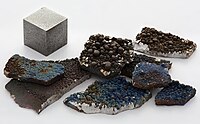
Photo from wikipedia
Hypoxia is a hallmark of many diseases, including cancer, arthritis, heart and kidney diseases, and diabetes, and it is often associated with disease aggressiveness and poor prognosis. Consequently, there is… Click to show full abstract
Hypoxia is a hallmark of many diseases, including cancer, arthritis, heart and kidney diseases, and diabetes, and it is often associated with disease aggressiveness and poor prognosis. Consequently, there is a critical need for imaging hypoxia in a noninvasive and direct way to diagnose, stage, and monitor the treatment and development of new therapies for these diseases. Eu-containing contrast agents for magnetic resonance imaging have demonstrated potential for in vivo imaging of hypoxia via changes in metal oxidation state from +2 to +3, but rapid oxidation in blood limits EuII-containing complexes to studies compatible with direct injection to sites. Here, we report a new EuII-containing complex that persists in oxygenated environments and is capable of persisting in blood long enough for imaging by magnetic resonance imaging. We describe the screening of a library of ligands that led to the discovery of the complex as well as a pH-dependent mechanism that hinders oxidation to enable usefulness in vivo. These studies of the first divalent lanthanide complex that persists in oxygenated solutions open the door to the use of EuII-based contrast agents for imaging hypoxia in a wide range of diseases.
Journal Title: Journal of the American Chemical Society
Year Published: 2022
Link to full text (if available)
Share on Social Media: Sign Up to like & get
recommendations!